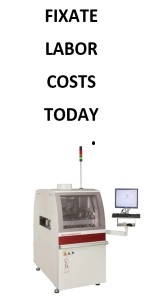Impact of FPC Fabrication Process on SMT Reliability
Published: |
December 5, 2013 |
Author: |
Susie Krzmarzick, John Dzarnoski, Yangjun Xing. |
Abstract: |
The functionality of electronic devices continues to increase at an extraordinary rate. Simultaneously consumers are expecting even more and in ever smaller packages. One enabler for shrinking electronics has been the flexible circuit board that allows the circuit board to fit a wide variety of shapes. Flexible printed circuits (FPC) have the capability to be very thin and can have unpackaged components directly attached using surface mount technology (SMT) and flip chip on flex technologies. Bare die can also be thinned and attached very close to the circuit board. However one caveat of high density flexible circuit boards with thin die is that they can be very fragile. The use of back side films and underfill can protect the die making circuits more robust. For underfill to work well it requires good adhesion to the circuit board which can mean that flux residues under the die normally must be removed prior to underfilling. ... |
|
|
|
Company Information:
More SMT / PCB assembly technical articles »
- Apr 11, 2022 - iNEMI Webinar 07.07.2021 - PCB Cleaning | ZESTRON Americas

- Jan 28, 2022 - Open Radio Unit White Box 5G | Whizz Systems

- Nov 10, 2021 - Understanding the Cleaning Process for Automatic Stencil Printers | ITW EAE

- Oct 20, 2021 - PCB Surface Finishes & The Cleaning Process - A Compatibility Study | ZESTRON Americas

- Oct 06, 2021 - Cleaning Before Conformal Coating | ZESTRON Americas

- Browse Technical Library »
Impact of FPC Fabrication Process on SMT Reliability article has been viewed 478 times







